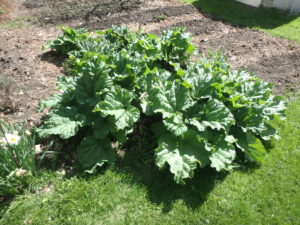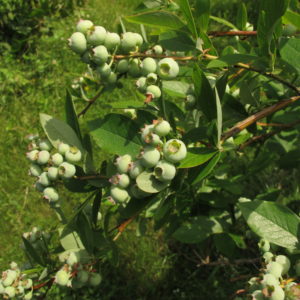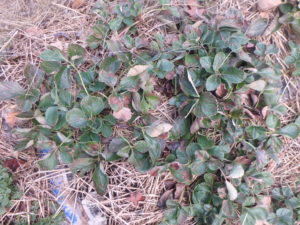Five Perennial Fruits and Vegetables for the Edible Landscape
When I make a new friend I always ask, “Are you a gardener?” Often younger people with kids say, “I want to, but I’m too busy.” If you have limited time and space, you may wish to consider growing a few perennial plants that produce lots of food – whether you do much for them or not.
If you are considering adding landscape plants to your yard, try thinking outside the box: instead of choosing traditional shrubs like hydrangeas or rhododendrons, what about blueberries and dwarf apples? What about strawberries to border the front walk instead of flowers?
Perennial fruits and vegetables generally require at least 6 hours of sunshine a day to succeed. Remember when planning that the arc the sun makes on July 4th is different than the arc in winter. And trees that are bare of leaves now may produce lots of shade in August when your berries are ripening.
Good soil is important for success. A soil test performed by your state Extension Service is a good investment. You need to know if you have adequate organic matter and minerals, and if the pH (a measure of acidity) is appropriate for what you want to grow.
If you have crummy soil – heavy clay, or very sandy – you may wish to grow your plants in raised beds so that you can build the soil needed. A 50-50 mix of compost and top soil is, in general, a good mix. Perennial plants tend to have deeper root systems than annuals like lettuce or tomatoes, so go with the deepest boxes possible. Eight-inch deep beds are good for almost anything.
Your perennial fruits and vegetables need about an inch of water per week- either from Mother Nature or from your hose. Traveling a lot? Forgetful? Think about an automatic timer and a drip system. Watering wands are great if you have to limit water use – you can direct the water directly to the plants, not to the walkways – or weeds! The soil should be well drained, but retain moisture after watering.
One of the easiest ways to keep down weeds and hold in moisture is with mulch. My favorite mulch is one I make myself: in the fall I mow the lawn, chopping up leaves and grass. I collect it and apply right on garden beds. After the first rain it is not likely to blow around. Or you can bag it in contractor trash bags, and store to use in the spring.
You can also buy bark mulch in bulk or by the bag. Avoid any that are colored, as they may have chemicals you don’t want on your fruits or veggies.
Here are some of my favorite perennial food plants:
- Asparagus: Modern cultivars in the “Jersey” series produce all-male plants, which produce much higher yields than older varieties (Washington series). Weeds are terrible enemies of asparagus, so mulch and weed carefully to keep weeds at bay. I use newspapers covered with bark mulch to keep down the weeds.
- Blueberries: The keys to success are a) to have the proper pH or level of acidity, and b) to keep the weeds down. Blueberries need very acidic soil, so test yours, and then add garden sulfur to bring the soil to a pH of 4.0-5.5. Top dress with sulfur or a fertilizer for acid–loving plants yearly right after blooming.
- Rhubarb: This can be grown with less sunshine than the berry plants – 4 hours of sunshine is sufficient, although more is better. Add a bucket of compost and a cup of organic fertilizer with each plant. Plant it where the soil stays lightly moist for best results.
- Raspberries and blackberries: If you like these berries, they are a must for your landscape: they don’t travel well and are expensive to buy. Because the plants tend to multiply and spread by root, this is a good plant to grow in a raised bed that will contain it. Plant in full sun in rich soil amended with compost and organic fertilizer.
- Strawberries: All season strawberries produce a few white blossoms and red berries all summer long, with a nice big crop in the fall when standard strawberries come from far away. Plant in full sun in rich, well-drained soil. Amend the soil with compost and organic fertilizer at planting time.
You don’t have to be a garden wizard to grow these things. Nor do you have to dedicate your life to them. So plan on doing some planting, come spring, and you’ll enjoy the benefits for years to come.
Henry started gardening with his Grampy some 70 years ago and still has the gardening bug. His books will guide you to success, just e-mail him for more info: henry.homeyer@comcast.net.





